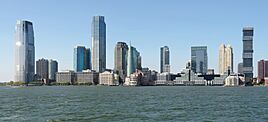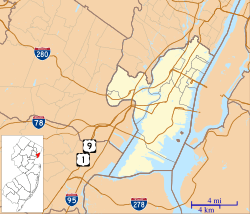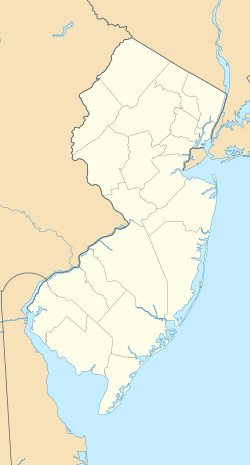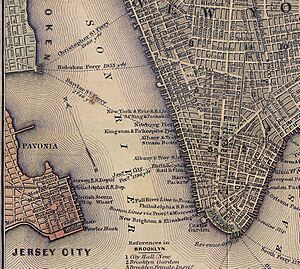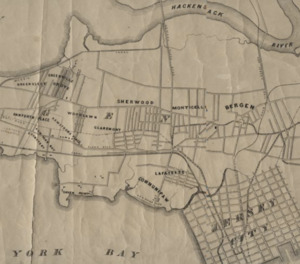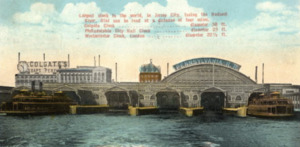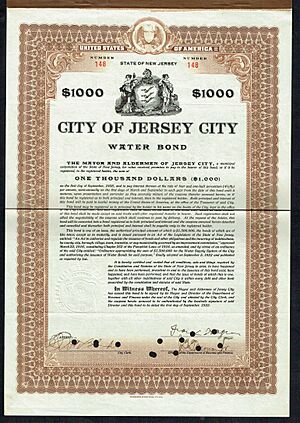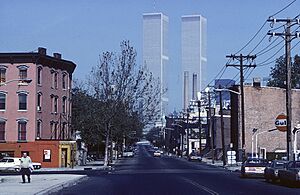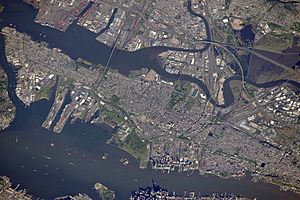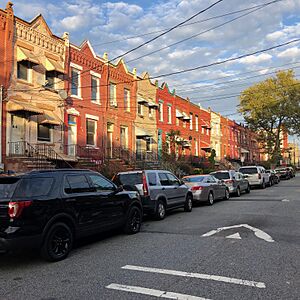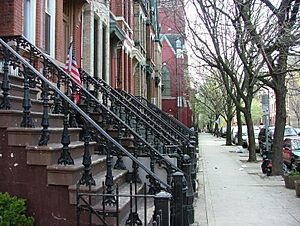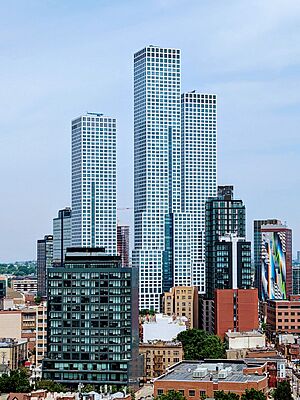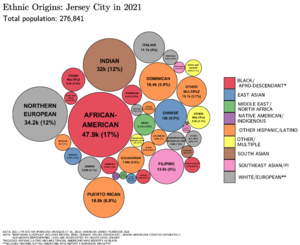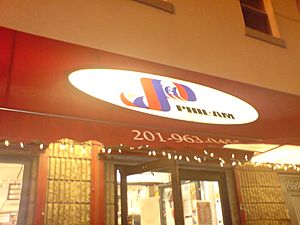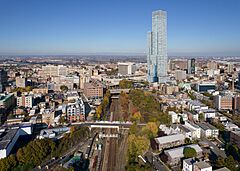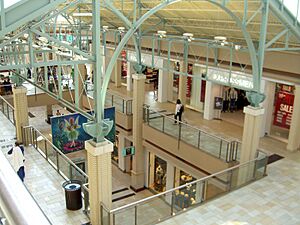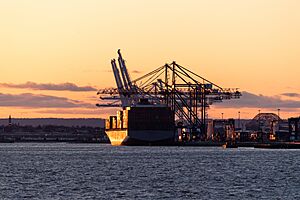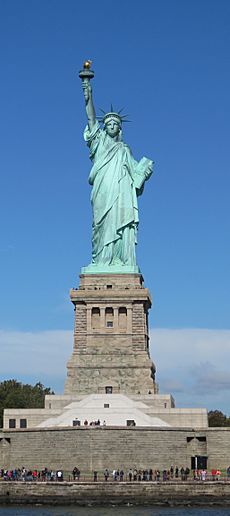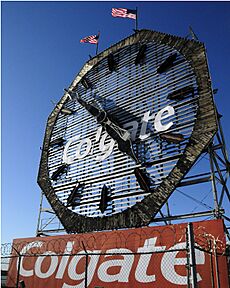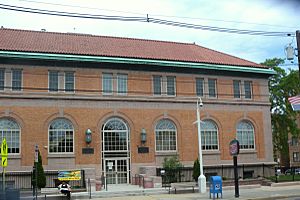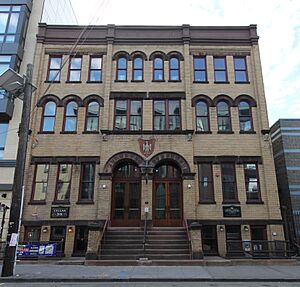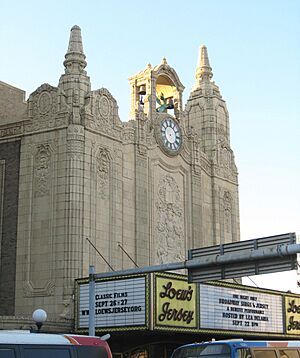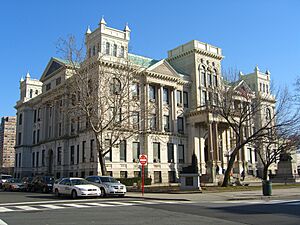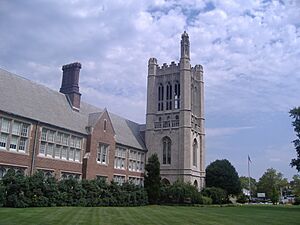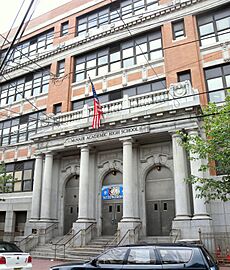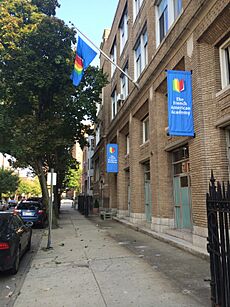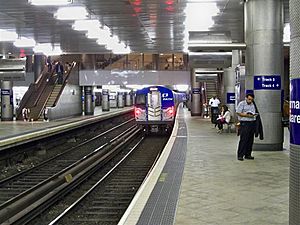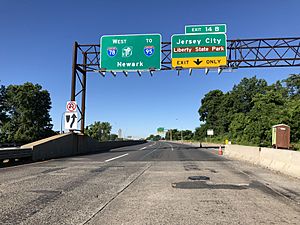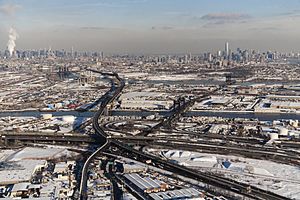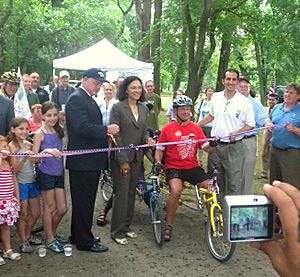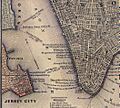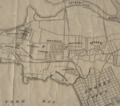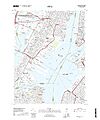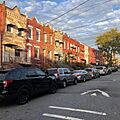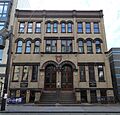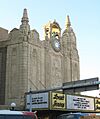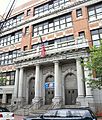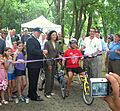Jersey City, New Jersey facts for kids
Quick facts for kids
Jersey City, New Jersey
|
|||||
|---|---|---|---|---|---|
|
City
|
|||||
| City of Jersey City | |||||
|
Downtown Jersey City skyline
|
|||||
|
|||||
| Nicknames:
JC, Chilltown, The Sixth Borough, America's Golden Door, Wall Street West
|
|||||
| Motto(s):
"Let Jersey Prosper"
"Jersey City, Make It Yours" |
|||||
| Country | |||||
| State | |||||
| County | Hudson | ||||
| European settlement | 1630 | ||||
| Incorporated | February 22, 1838 | ||||
| Named for | New Jersey | ||||
| Government | |||||
| • Type | Faulkner Act (mayor–council) | ||||
| • Body | City Council | ||||
| Area | |||||
| • Total | 21.03 sq mi (54.48 km2) | ||||
| • Land | 14.75 sq mi (38.20 km2) | ||||
| • Water | 6.29 sq mi (16.28 km2) 30.24% | ||||
| Area rank | 134th of 565 in state 1st of 12 in county |
||||
| Elevation | 20 ft (6 m) | ||||
| Population
(2020)
|
|||||
| • Total | 292,449 | ||||
| • Estimate
(2024)
|
302,824 | ||||
| • Rank | 70th in country (as of 2024) 2nd of 565 in state 1st of 12 in county |
||||
| • Density | 19,835.1/sq mi (7,658.4/km2) | ||||
| • Density rank | 10th of 565 in state 7th of 12 in county |
||||
| Time zone | UTC−05:00 (EST) | ||||
| • Summer (DST) | UTC−04:00 (Eastern (EDT)) | ||||
| ZIP Codes |
07097, 07302-07308, 07310-07311
|
||||
| Area code(s) | 201/551 | ||||
| FIPS code | 3401736000 | ||||
| GNIS feature ID | 0885264 | ||||
Jersey City is a vibrant place in New Jersey. It is the second-largest city in the state, right after Newark. It is also the main city of Hudson County. In 2020, about 292,449 people lived here. By 2024, the population grew to over 302,000, making it one of the largest cities in the United States.
Jersey City is known for being very diverse. More than 40 languages are spoken in over half of its homes. In 2020, about 42.5% of its residents were born outside the United States. This makes it one of the most diverse cities in the country.
The city sits on the Hudson River and Upper New York Bay to the east. To the west, it borders the Hackensack River and Newark Bay. It is a major port of entry with a long waterfront and many train lines. This makes it an important center for shipping and trade. The Holland Tunnel, PATH trains, and NY Waterway ferry services connect Jersey City to Manhattan.
Dutch settlers first arrived in the 1600s, calling the area Pavonia. It later became Bergen, the first permanent settlement and local government in New Jersey. The English took control in 1664. Jersey City officially became a city in 1838. Its motto, "Let Jersey Prosper," comes from a border dispute with New York City in the 1800s.
Jersey City has many colleges, like New Jersey City University and Saint Peter's University. It is also home to the Hudson County Courthouse. Fun places to visit include the Liberty Science Center, Ellis Island, and the Museum of Jersey City History. Large parks like Liberty State Park offer great outdoor spaces. The city's waterfront has become a major center for banking and finance, earning it the nickname "Wall Street West". Many artists and young people have moved to Jersey City since the 1990s. Its close ties to Manhattan and growing arts scene have made it a popular place to live.
Contents
- History of Jersey City
- Geography of Jersey City
- People and Cultures
- Economy of Jersey City
- Notable Landmarks in Jersey City
- Art and Culture in Jersey City
- Government of Jersey City
- Education in Jersey City
- Transportation in Jersey City
- Hospitals and Healthcare
- Images for kids
- See also
History of Jersey City
Early Settlements and Dutch Influence
The land where Jersey City now stands was once home to the Lenape Native American tribes. In 1609, Henry Hudson explored the area for the Dutch. He claimed the region for the Netherlands. The city's flag today still uses blue, white, and yellow, like the old Dutch flag. It shows Hudson's ship, the Half Moon.
In 1621, the Dutch West India Company began managing this new territory. By 1623, it was called New Netherland. A man named Michael Reyniersz Pauw received land here in 1630. He bought the land from the Lenape. This was the first known land deal for what is now Hoboken and Jersey City.
The first Dutch house was built in 1633 at Communipaw. It was part of a settlement called Pavonia. Relations with the Lenape became difficult. In 1643, about 120 Lenape people were killed by the Dutch in a terrible event at Pavonia. In 1655, Pavonia was attacked again, and many colonists were captured.
In 1658, Peter Stuyvesant bought back the scattered Dutch settlements. The village of Bergen was founded in 1660. It was a safe, walled community. In 1661, Bergen became New Jersey's first local government. It is considered the oldest town in the state. The oldest houses in Jersey City, like the Newkirk House (1690), are Dutch.
English Control and the American Revolution
In 1664, the English took over New Netherland. The Duke of York gave the land to Sir George Carteret. He named it New Jersey after his home island. The English allowed Dutch residents to keep their way of life.
By the 1760s, Paulus Hook was a busy spot for travel. Cornelius Van Vorst started the Paulus Hook Ferry in 1764. He also built a horse racing track and a tavern to attract visitors.
The Battle of Paulus Hook
During the American Revolutionary War, American soldiers built a fort at Paulus Hook. It was a strong position to defend against the British. In 1776, the Americans left the fort, and the British took it over.
In 1779, Major Light Horse Harry Lee led a surprise attack on the fort. His American forces captured 158 British soldiers. They damaged the fort but could not destroy it. The British kept control of Paulus Hook until after the war. This battle was a small but important victory for the Americans.
Later in 1779, General George Washington met with the Marquis de Lafayette in Bergen. They discussed war plans at the Van Wagenen House. This house is now the Museum of Jersey City History.
In 1780, a local farmer named Jane Tuers helped uncover a plot. She learned that General Benedict Arnold planned to betray West Point to the British. Her information helped stop the plot.
The British left Paulus Hook in 1783. In 1903, a monument was built at Paulus Hook Park to remember the battle. A plaque honoring Jane Tuers was placed in 1925.
Growth in the 1800s
In 1804, Alexander Hamilton helped create the "Associates of the Jersey Company." This group planned the modern layout of Jersey City. They bought land and designed streets and squares. Hamilton believed a "great city" would rise here.
The "Town of Jersey" was officially created in 1820. It became fully independent in 1838 and was named Jersey City. In 1840, Jersey City became part of the new Hudson County.
In 1812, Robert Fulton started steam ferry service between Paulus Hook and Manhattan. In 1834, the first train line opened, connecting Jersey City to Newark. The Morris Canal was extended to Jersey City in the 1830s. This helped bring coal and iron to the city, boosting its industries.
Jersey City grew quickly. In 1851, it took over Van Vorst Township. The Van Vorst Park was created from land donated by the Van Vorst family.
The city faced challenges with fresh water. In the 1850s, engineers built reservoirs to bring water to the city. The Evening Journal newspaper started in 1867. It later moved to the area now known as Journal Square.
In 1868, the city opened the "Jersey City Charity Hospital." It was the first public hospital in New Jersey.
The Underground Railroad
During the 1800s, Jersey City was a key stop on the Underground Railroad. This secret network helped enslaved people escape to freedom. The Hilton-Holden House on Bergen Hill was a "safe house" for them. Abolitionists helped hide people in wagons and on boats to reach New York or Canada. It is thought that over 60,000 people passed through Jersey City on their way to freedom. Some even stayed and made the city their home.
Brothers Thomas and John Vreeland Jackson, who were formerly enslaved, bought land in Greenville. Their property became an important station on the Underground Railroad. The Jackson Hill neighborhood is named after them.
City Consolidation
After the Civil War, there was a plan to unite all the towns in Hudson County. In 1870, Jersey City merged with Hudson City and Bergen City. This created "Greater Jersey City." In 1873, Greenville Township also joined.
Saint Peter's College opened in 1872. Its mascot, the peacock, refers to the original name of the area, "Pavonia," meaning "land of the peacock."
In 1886, the Statue of Liberty was dedicated near Jersey City. It welcomed millions of immigrants arriving at Ellis Island, which opened in 1892.
By the late 1800s, Jersey City had three major train terminals. These made it a hub for the nation's rail network. Many immigrants passed through these terminals to enter the United States. The railroads changed the city's landscape, creating tunnels and large rail yards.
Jersey City became a busy port and manufacturing city. Immigrants from Germany, Russia, Poland, Ireland, and Italy settled here. They found work on the docks, railroads, and in factories. Social reformers like Cornelia Foster Bradford helped the immigrant poor. She founded Whittier House in 1894, New Jersey's first "settlement house."
The 1900s and Beyond
In the early 1900s, Jersey City focused on creating more public parks. Lincoln Park opened in 1905 as the city's largest park. Other parks like Dr. Leonard J. Gordon Park were also built.
In 1908, Jersey City became the first city in the U.S. to use chlorine to disinfect its drinking water. The Hudson & Manhattan Railroad (now PATH) opened between 1908 and 1913. This underground train system connected Jersey City directly to Manhattan.
William L. Dickinson High School opened in 1910. Its hilltop location was important during the Revolutionary War and the War of 1812.
On July 30, 1916, the Black Tom explosion happened. This was an act of sabotage by German spies during World War I. It caused huge damage in Jersey City and the New York area. This event helped push the U.S. into the war.
Mayor Frank Hague's Era
From 1917 to 1947, Frank Hague was the mayor of Jersey City. He was a powerful political leader. He helped build many important projects, including Journal Square theaters, the Holland Tunnel, and the Pulaski Skyway. He also expanded the Jersey City Medical Center.
After World War II
After World War II, many veterans moved to the suburbs. Jersey City built new housing to keep its population stable. College Towers and Country Village were built as new communities.
In the 1950s, the Newark Bay Extension (I-78) opened. This connected Jersey City to the Turnpike. Shipping changed with the introduction of containers. Old port facilities became outdated. Port Jersey was created in the 1970s as a modern shipping terminal.
In the 1960s, community leaders protested plans to turn Kennedy Boulevard into a highway. Their efforts led to the plan being stopped and a ban on truck traffic.
In August 1964, there was civil unrest in the Lafayette neighborhood. City leaders met with community groups to address concerns.
By the 1970s, Jersey City faced economic challenges. Many industries left, and people moved away. The city lost many residents and jobs.
Hudson County Community College was founded in 1974 in Journal Square. In 1974, the city council changed a 40-year-old law that banned women from drinking at bars and working as bartenders.
In 1976, Liberty State Park opened. It is the largest park in Jersey City. It was built on old train yards. The Liberty Science Center opened in the park in 1993.
Recent Times: Late 1900s and Early 2000s
Starting in the 1980s, Jersey City began to grow again. Old brownstone homes were restored. The waterfront, once filled with train yards and factories, was redeveloped. New high-rise buildings were built, like those in Newport. This led to the creation of the Exchange Place financial district, known as "Wall Street West". Many large financial companies have offices here.
Since 1988, developers have been required to build the Hudson River Waterfront Walkway. This public path runs along the Hudson River. Ferry service to Manhattan was also restored. The Hudson-Bergen Light Rail opened between 1996 and 2011. This train system connects Jersey City to nearby cities.
September 11, 2001
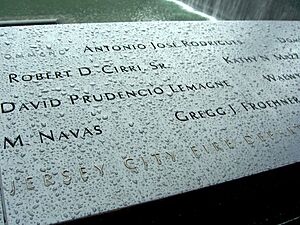
Jersey City was deeply affected by the September 11, 2001, attacks on the World Trade Center. Thirty-eight residents of Jersey City lost their lives. The Jersey City Fire Department helped with rescue efforts. The waterfront became a large center for helping survivors who escaped Manhattan by ferry.
Over the years, memorials have been built. These include the Jersey City 9/11 Memorial and the New Jersey state memorial Empty Sky.
2010s to Today
In 2011, Hurricane Irene caused flooding in Downtown Jersey City. In 2012, Hurricane Sandy heavily impacted the city. There were long power outages and widespread flooding.
In 2013, Jersey City became the first city in New Jersey to require paid sick days for many workers. This was a big step for worker rights.
Jersey City's population continued to grow. From 2010 to 2014, it had the largest population increase of any city in New Jersey.
From 2018 to 2023, Jersey City built a new municipal complex called Jackson Square. This brought many city offices together.
On December 10, 2019, a shooting occurred at a kosher grocery store in Greenville. This was a domestic terrorist attack.
COVID-19 Pandemic
The first case of COVID-19 in Jersey City was confirmed on March 13, 2020. The city quickly put in place rules to slow the virus. Jersey City became a major center for the virus in New Jersey. By March 2023, 320 residents had died from COVID-19. In April 2023, the Jersey City Medical Center opened a garden to honor those affected.
Geography of Jersey City
Jersey City is the second-largest city in New Jersey by population. It covers about 21 square miles. About 14.7 square miles is land, and 6.4 square miles is water.
The city is bordered by Manhattan and Brooklyn to the east across the Hudson River. To the north are Secaucus, North Bergen, Union City, and Hoboken. To the west, across the Hackensack River, are Kearny and Newark. Bayonne is to the south.
Jersey City includes most of Ellis Island. Liberty Island is also surrounded by Jersey City's waters. Because it is so close to Manhattan, Jersey City is sometimes called New York City's "sixth borough".

Jersey City is on a peninsula called Bergen Neck. It has waterfronts on both the Hudson River and the Hackensack River. The city's hills, part of the Hudson Palisades, have shaped how its neighborhoods developed.
Neighborhoods of Jersey City
Jersey City is divided into six main areas called wards.
Bergen-Lafayette
This area is between Greenville to the south and McGinley Square to the north. It borders Liberty State Park and Downtown to the east. Main streets include Communipaw Avenue and Martin Luther King Drive. The old Jersey City Medical Center buildings have been turned into homes called The Beacon. Berry Lane Park, a large city park, opened here in 2016. The Jersey City Municipal Complex opened in phases at Jackson Square from 2018 to 2023.
Downtown Jersey City
Downtown Jersey City stretches from the Hudson River west to the New Jersey Turnpike. It is bordered by Hoboken to the north and Liberty State Park to the south.
Historic Downtown has many low-rise buildings. It is popular because it is close to Manhattan. It includes Van Vorst Park and Hamilton Park, which are parks surrounded by historic brownstone homes. Other neighborhoods here are Paulus Hook, the Village, and Harsimus Cove. Newark Avenue and Grove Street are busy areas with many shops and restaurants. The Grove Street PATH station has been updated.
Newport and Exchange Place are redeveloped waterfront areas. They have many tall residential and office buildings. Newport is a planned community with homes, offices, shops, and a mall. These areas have helped Jersey City's economy grow.
The Heights
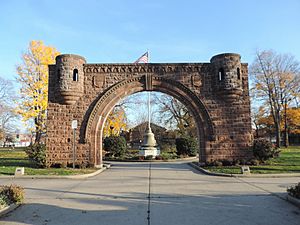
The Heights is in the northern part of Jersey City. It sits on top of the New Jersey Palisades, looking over Hoboken. It used to be the city of Hudson City before joining Jersey City in 1869. The Heights mostly has two- and three-family houses.
Journal Square
Journal Square is a busy central area with many businesses. It was created in 1923. Other important spots nearby include Bergen Square, India Square, and Five Corners. McGinley Square is also close by. The Journal Square Transportation Center is a major hub for buses and PATH trains. Hudson County Community College is located here. Journal Square is seeing a lot of new building construction.
Greenville
Greenville is in the southern part of Jersey City. It has been revitalized in recent years. Many families have moved here because homes are more affordable than in New York City.
West Side
The West Side borders Greenville to the south and the Hackensack River to the west. It includes various areas around West Side Avenue, a main shopping street. The Hudson-Bergen Light Rail serves this area. The New Jersey City University and Saint Peter's University are located on the West Side.
People and Cultures
Jersey City is known as one of the most diverse cities in the world. It is a major entry point for immigrants to the United States. This has created a rich mix of cultures and backgrounds.
The city has programs to help immigrant communities. In 2017, Jersey City became a "sanctuary city". In 2018, it created the Division of Immigrant Affairs. This office helps immigrants with health, legal services, education, and job training. In 2020, Jersey City became the first U.S. city to offer free legal services to immigrants.
According to the 2020 U.S. Census, the city's population includes many different groups. About 27.3% are White, 19.9% are Black or African American, and 28.0% are Asian. About 24.9% of residents are Hispanic or Latino.
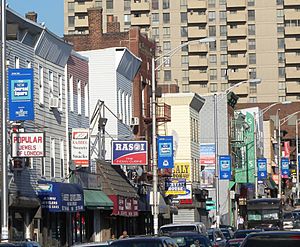
India Square, also called "Little India", has the largest number of Asian Indians in the Western Hemisphere. It hosts large outdoor festivals and Hindu temples. The annual Holi festival attracts many people.
Filipino Americans are the second-largest Asian-American group in Jersey City. The Five Corners area is a "Little Manila" with many Filipino businesses. Manila Avenue is named for the Philippine capital. The city also hosts an annual Philippine–American Friendship Day Parade.
After English and Spanish, Tagalog is the third most common language spoken in Jersey City.
The city also has a growing population of Chinese Americans and Vietnamese Americans. There is also a significant Arab American community, including many Coptic Christians.
LGBTQ+ Community
Jersey City is known as a very LGBT-friendly city. It has received high scores for LGBTQ+ equality in its laws and services for many years.
The Hudson Pride Connections Center in Journal Square is the largest LGBTQ+ social services center in New Jersey. It supports the well-being of the LGBTQ+ community.
Every August, Jersey City hosts the Jersey City LBGTQ+ Pride Festival. It is one of the largest pride festivals in New Jersey, attracting over 25,000 people.
Religion in Jersey City
Most people in Jersey City are religious. About 46.2% are Catholic Christians, and 7.3% are Protestant Christians. Muslims make up 3.4% of religious followers. Other religions like Buddhism, Hinduism, and Sikhism make up 1.5%. There is also a growing Orthodox Jewish community in the Greenville neighborhood.
Economy of Jersey City
Jersey City is a major employment center. It has over 100,000 jobs in both private and public sectors. Many jobs are in finance, services, shipping, and retail. From 2020 to 2021, the number of jobs in Jersey City increased by over 8%. Tech and IT jobs made up a large part of this growth.
The city's tax base grew significantly in 2017. This made Jersey City's tax base the largest in New Jersey.
Wall Street West

The waterfront area, from Exchange Place to Newport, is called Wall Street West. It has a huge amount of office space, making it one of the largest financial centers in the U.S. Over one-third of the city's private sector jobs are in financial services.
Many large financial companies have offices here, including UBS, Goldman Sachs, Chase Bank, and Citibank. In 2014, Forbes magazine moved its headquarters to Jersey City. In 2015, JPMorgan Chase expanded its presence. In 2024, Bank of America leased a large amount of office space in Newport Tower.
Life Science and Technology
The life science and technology industry is growing fast in Jersey City. In 2024, Jersey City was ranked the 5th top tech city in the U.S. It has 394 tech and IT firms.
In 2020, Organon International opened its headquarters at the Goldman Sachs Tower. In 2021, the Liberty Science Center started building SciTech Scity. This 30-acre campus will be a hub for life sciences and technology. It will include labs, research spaces, and a new STEM high school.
Another innovation hub called "The Cove" was announced in 2022. It will have life science offices, homes, and a public park. Biotechnology firms like EpiBone and RegenLab USA have moved to Jersey City. In 2025, AI and IT company Hexaware Technologies leased an entire floor at Harborside for its global headquarters.
Sports Betting Industry
Jersey City has become a leader in the sports betting industry. Companies like BetMGM and Caesars Sports Book have their headquarters here. Other sports betting companies like FanDuel and Draft Kings also have offices in the city.
Shopping and Retail
Jersey City has several shopping areas. Some are traditional main streets like Central Avenue and Newark Avenue. Lower Newark Avenue became a permanent pedestrian plaza in 2022, with many restaurants and cultural spots. Journal Square is a major commercial district.
The city has two malls: Newport Centre Mall in Downtown and Hudson Mall on the West Side.
Parts of the city are in an Urban Enterprise Zone (UEZ). This program offers a reduced sales tax rate (3.3125%) at eligible stores. Jersey City's UEZ is the largest and most productive in the state.
E-commerce and Distribution
Jersey City is also a center for e-commerce and distribution. Imperial Dade opened a large distribution center here in 2013. Goya Foods opened a new headquarters and distribution center in 2015. Nuts.com moved its headquarters to Exchange Place in 2019. In 2024, CVS Health leased a large space at HRP Hudson Logistics Park.
Port Jersey
Port Jersey is a large shipping facility on the Upper New York Bay. It handles many containers. The northern part has the Greenville Yard, a rail yard. New York New Jersey Rail operates a unique car float service here. The port has expanded with new cranes and tracks to handle more cargo.
Notable Landmarks in Jersey City
- The Statue of Liberty National Monument, Ellis Island and Liberty Island are iconic symbols of freedom. While Liberty Island and part of Ellis Island are in New York, they are very close to Jersey City.
- The Liberty Science Center is a large science museum in Liberty State Park. It has interactive exhibits and the world's largest IMAX Dome theater. In 2017, it opened the Jennifer Chalsty Planetarium, the largest in the Western Hemisphere.
- The Peter Stuyvesant Monument honors Peter Stuyvesant, who helped establish the settlement of Bergen in 1660.
- The Katyń Memorial on Exchange Place honors the victims of the Katyń Forest Massacre.
- The Lincoln the Mystic is a memorial to Abraham Lincoln at the entrance to Lincoln Park.
- The Colgate Clock is a huge clock that faces Lower New York Bay. It was built in 1924 and is said to be the largest in the world.
- The Landmark Loew's Jersey Theatre is a historic movie palace in Journal Square. Built in 1929, it is being restored and will reopen as a modern performing arts venue in 2026.
- The Van Wagenen House, also called the "Apple Tree House," is one of the oldest buildings in Jersey City. It is now the Museum of Jersey City History.
- The White Eagle Hall is a historic theater that reopened in 2017. It hosts live performances and events.
- The Jersey City 9/11 Memorial remembers the 38 Jersey City residents who died in the September 11 attacks.
- The Empty Sky memorial in Liberty State Park honors the New Jersey residents killed in the 1993 World Trade Center bombing and the September 11 attacks.
- The Statue of Mary McLeod Bethune is the first statue in Jersey City to honor an African American woman.
Art and Culture in Jersey City
Jersey City is known as an artistic city. A 2011 survey called it the 10th most artistic city in the U.S. In 2022, the city's arts and culture sector generated $46 million in economic activity.
Museums, Libraries, and Galleries
The Jersey City Free Public Library is the largest library system in New Jersey. It has a main library and ten branches. The newest branch, the Communipaw Branch, opened in 2024. It is a public innovation hub for STEAM learning.
The Main Library has a special "New Jersey Room" with historical documents about the state and Jersey City. The Afro-American Historical and Cultural Society Museum is located in the Greenville Branch Library. It showcases the history of Jersey City's African American community.
The Museum of Jersey City History has exhibitions about the city's past.
Liberty State Park is home to the Central Railroad of New Jersey Terminal and the Liberty Science Center. The science center has many exhibits and the largest planetarium in the Western Hemisphere. Ferries from the park go to Ellis Island and the Statue of Liberty.
Other art spots include the Jersey City Museum, Mana Contemporary, and the Museum of Russian Art. Some Hudson Bergen Light Rail stations also feature public art. Jersey City has many art galleries, including Drawing Rooms and Novado Gallery.
Performing Arts
White Eagle Hall is a performing arts venue in Downtown Jersey City. It opened in 1910 and reopened in 2017 after renovations. It hosts dance and theater performances.
The Loew's Jersey Theatre is a historic movie palace and performing arts venue in Journal Square. It is undergoing a major renovation and is set to reopen in 2026.
Monty Hall is a live performing arts space run by WFMU radio station. Nimbus Arts Center and Art House Productions Theater Center also offer dance, theater, and music performances.
The New Jersey Symphony is opening its first permanent venue in Jersey City in 2026. This "Symphony Center" will be a hub for concerts and classes.
Universities in Jersey City also have venues for theater, dance, and music.
Murals and Public Art
Since 2013, the Jersey City Mural Arts Program (JCMAPS) has worked with artists to create over 200 murals across the city. This program helps reduce graffiti and beautifies the city.
The Jersey City Youth Mural Arts Program (JCYMAP) started in 2014. It teaches young artists how to create public art.
Festivals and Events
Jersey City hosts many annual arts festivals and events. These include the Jersey City Art & Studio Tour (JCAST) and Art Fair 14C. JC Fridays is a city-wide arts festival held four times a year.
Groove on Grove is a free summer music series. The Hudson Shakespeare Company performs free Shakespeare plays in city parks during the summer. The Ghost of Uncle Joe's is an annual music festival fundraiser for the Historic Jersey City and Harsimus Cemetery.
The annual Jersey City Ward Tour is a bike event that takes riders through all six wards. The All About Downtown Street Fair attracts thousands of people.
The Jersey City Jazz Festival, started in 2013, is the largest jazz festival in the New York area. The Jersey City Latin Jazz Festival also began in 2024.
Jersey City hosts a large 4th of July fireworks celebration at Exchange Place. It features concerts with famous artists like Snoop Dogg and Flo Rida.
Since 2015, Jersey City has co-hosted New York City's annual Fleet Week at Liberty State Park. The Jersey City Mural Arts Festival started in 2021. The annual Juneteenth All About Us Festival began in 2023 at Liberty State Park.
The city also hosts two annual restaurant weeks to celebrate its local food scene.
Government of Jersey City
Jersey City is governed by a Mayor and a nine-member City Council. Six council members are elected from different wards, and three are elected from the city as a whole. They all serve four-year terms.
As of 2025, Steven Fulop is the Mayor of Jersey City. His term ends on December 31, 2025. Former New Jersey Governor Jim McGreevy announced in November 2023 that he would run for mayor.
The City Council members include Council President Joyce Watterman, Richard Boggiano, Amy M. DeGise, Frank E. Gilmore, Mira Prinz-Arey, Denise Ridley, Daniel Rivera, Yousef J. Saleh, and James Solomon. Their terms also end on December 31, 2025.
In April 2020, Yousef J. Saleh was appointed to fill a vacant council seat after Michael Yun passed away. Voters then chose Saleh to serve the rest of the term in November 2020.
The Business Administrator is John J. Metro, and the City Clerk is Sean J. Gallagher.
Emergency Services
- The Jersey City Fire Department has 667 firefighters. It is the largest fire department in New Jersey. It also has the only High-Rise Firefighting Unit in the state.
- The Jersey City Police Department has over 950 officers. It is divided into four districts.
- Emergency Medical Services are provided by the Jersey City Medical Center.
Education in Jersey City
Colleges and Universities
Jersey City is home to several colleges and universities:
- New Jersey City University is a public university on the West Side. It started in 1927 and first focused on training teachers.
- Saint Peter's University is a private Jesuit university on the West Side. It was founded in 1872.
- Hudson County Community College, established in 1974, is a public community college in Journal Square.
- Rutgers University offers MBA classes at Harborside Financial Center.
- New Jersey Institute of Technology offers master's programs in artificial intelligence and computer science at Exchange Place.
Public Schools
The Jersey City Public Schools serve students from pre-kindergarten through 12th grade. The district has 39 schools and over 27,000 students.
High schools in the district include:
- William L. Dickinson High School
- James J. Ferris High School
- Infinity Institute
- Innovation High School
- Liberty High School
- Lincoln High School
- Dr. Ronald E. McNair Academic High School
- Renaissance Institute
- Henry Snyder High School
Dr. Ronald E. McNair Academic High School is highly ranked in New Jersey and the U.S. William L. Dickinson High School is the oldest high school in the city.
The Hudson County Schools of Technology also has a campus in Jersey City, which includes County Prep High School.
Jersey City also has 12 charter schools, which are public schools run independently.
Private Schools
Catholic Schools
The Roman Catholic Archdiocese of Newark runs several Catholic schools in Jersey City. These include:
- Hudson Catholic Regional High School
- Saint Dominic Academy
- St. Peter's Preparatory School
Some Catholic elementary schools are Our Lady of Czestochowa School, Sacred Heart School, Saint Aloysius Elementary Academy, St. Joseph School, and St. Nicholas School. Our Lady of Czestochowa School was recognized as a National Blue Ribbon School in 2015.
Several Catholic schools have closed over the years due to fewer students and rising costs.
Other Private Schools
Other private high schools include First Christian Pentecostal Academy and Stevens Cooperative School. Kenmare High School helps women reduce poverty through small classes and life skills. The French American Academy is a private bilingual school. Genesis Educational Center is a private Christian school. The Jersey City Art School is a private art school for all ages.
Transportation in Jersey City
Many Jersey City residents use public transportation. About 46.6% of commuters take public transit, which is one of the highest percentages in the U.S. Also, 40.7% of households do not own a car.
Air Travel
- Newport Helistop Heliport is a heliport on the Hudson River.
- Newark Liberty International Airport is the closest major airport.
Mass Transit
Trains
- Hudson-Bergen Light Rail: This popular light rail system has 13 stations in Jersey City.
- PATH: This 24-hour train system has four stations in Jersey City: Exchange Place, Newport, Grove Street, and Journal Square. It connects to Hoboken, Midtown Manhattan, Lower Manhattan, and Newark.
- Hoboken Terminal: Located near Jersey City, this terminal offers many NJ Transit train lines to various parts of New Jersey and New York.
Buses
The Journal Square Transportation Center, Exchange Place, and Hoboken Terminal are major bus hubs. NJ Transit buses serve many areas in Jersey City, Hudson County, and Manhattan.
"Dollar vans" or jitneys are also popular for local travel. In February 2020, Jersey City launched Via Jersey City, an on-demand transit service. It helps connect neighborhoods to train and ferry stops.
Ferries
- NY Waterway ferries connect Paulus Hook, Liberty Harbor, and Port Liberté in Jersey City to Manhattan.
- Statue Cruises provides ferry service to Ellis Island and Liberty Island from Liberty State Park.
- Liberty Landing Ferry operates between Liberty Landing Marina and Manhattan.
Roads and Bridges
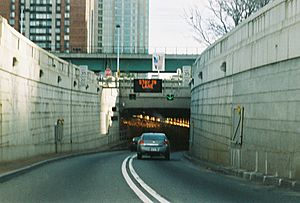
Jersey City has over 218 miles of roads.
- The Holland Tunnel connects Downtown Jersey City to Manhattan.
- Major highways include the New Jersey Turnpike Extension (Interstate 78), the Pulaski Skyway (U.S. Route 1/9), and Route 139.
- Important bridges include the Lincoln Highway Hackensack River Bridge and the Wittpenn Bridge.
Bike Paths
Part of the East Coast Greenway, a bike route from Maine to Florida, will go through Jersey City. The Hudson River Waterfront Walkway and Hackensack RiverWalk are also bike-friendly.
The city has been adding bike lanes since 2012. In 2019, Jersey City got its first protected bike lanes. By 2024, there were 22 miles of protected bike lanes.
In 2013, Jersey City made it easier to install bike racks. In 2015, the Citi Bike bike-share program launched, allowing members to use bikes in Jersey City and New York City. In June 2025, 25 new Citi Bike stations were added to the system.
In 2024, the city launched the first municipal secure bike parking and charging network in the U.S. It includes storage pods and charging stations for e-bikes.
Pedestrian Safety
In 2018, Jersey City adopted the Vision Zero initiative to make streets safer for pedestrians. The city has added features like special traffic lights for pedestrians and improved crosswalks. These efforts helped Jersey City have no traffic deaths on city-maintained streets in 2022.
Hospitals and Healthcare
Jersey City has two main hospitals:
- Jersey City Medical Center (JCMC) is a large hospital in Downtown Jersey City. It is a regional trauma center and teaching hospital. It is part of RWJBarnabas Health, New Jersey's largest hospital network. JCMC is the city's oldest hospital, dating back to 1868.
- Christ Hospital is a private hospital in The Heights. Established in 1872, it is the second oldest and second largest hospital in Jersey City.
Jersey City Medical Center at Greenville is an outpatient and urgent care center in Greenville. It opened in 2015 in the building of the former Greenville Hospital.
Englewood Health ZT Systems Outpatient Center opened in Journal Square in 2022. It offers outpatient medical services.
Saint Francis Hospital, founded in 1864, closed in 2005 and was converted into homes.
Images for kids
See also
 In Spanish: Ciudad de Jersey para niños
In Spanish: Ciudad de Jersey para niños
- Bergen Township, New Jersey (1661–1862)
- Demographics of New Jersey
- Gold Coast, New Jersey
- Northeast Megalopolis
- Timeline of Jersey City area railroads
- Transportation in New Jersey
- Van Vorst Township, New Jersey


